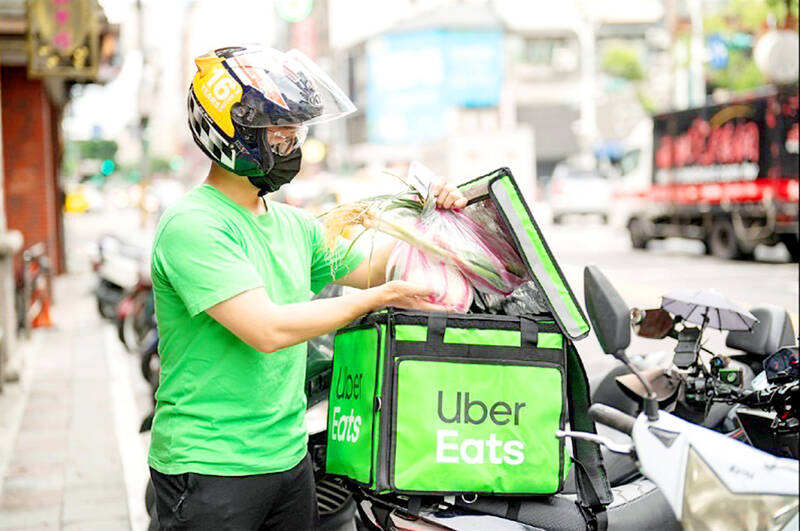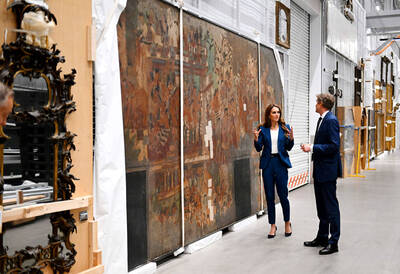Taiwan is learning from companies in Ukraine which continue to operate during the country’s fight against Russia, a senior Taiwan official said yesterday, as the natioin speeds up contingency planning amid heightened Chinese threats.
“We hope to learn from Ukraine’s first-hand experiences — how private companies helped build the resilience of its government and society during wartime,” said a senior Taiwan security official, who requested anonymity due to the sensitivity of the matter.
The official pointed to companies in Ukraine including Uber and Microsoft that continued to provide critical services.

Photo: Taipei Times, file photo
Ideas include how to incorporate supermarkets into the government’s supply distribution network and utilizing taxi services for medical emergencies such as blood donations when the health system is overwhelmed.
The official said the government was working to connect companies in Taiwan with their counterparts in Ukraine in order to help Taiwan firms quickly boost their contingency planning.
“We have the will to fight, and now we must also look closely into our will to prepare,” the official said.
Taiwan is revamping its air-raid alert and shelter systems, taking into account lessons by northern European countries and Baltic states, the official added.
A closed-door workshop on preparations including stockpiling and civil defense training was held in Taipei this week, which was attended by Taiwan security officials and senior diplomats from countries including the US, Japan and Australia.
Andy Hunder, who heads the American Chamber of Commerce in Ukraine and is a speaker at the workshop, told reporters the government must establish backup online systems, pointing to Russian cyber attacks aimed at paralyzing Ukraine infrastructure before the first missile attacks.
“What we have seen is that during World War Two, the safest place for critical infrastructure is down in the tunnels. Today, the safest infrastructure is in the clouds,” Hunder said, adding payment services such as Mastercard and Visa continued to operate and ensured financial stability.
“Technology, banking, food, delivery, retail — how do you keep the economy running?” he said when asked how the Taiwan government should prepare itself.

June 9 to June 15 A photo of two men riding trendy high-wheel Penny-Farthing bicycles past a Qing Dynasty gate aptly captures the essence of Taipei in 1897 — a newly colonized city on the cusp of great change. The Japanese began making significant modifications to the cityscape in 1899, tearing down Qing-era structures, widening boulevards and installing Western-style infrastructure and buildings. The photographer, Minosuke Imamura, only spent a year in Taiwan as a cartographer for the governor-general’s office, but he left behind a treasure trove of 130 images showing life at the onset of Japanese rule, spanning July 1897 to

One of the most important gripes that Taiwanese have about the Democratic Progressive Party (DPP) is that it has failed to deliver concretely on higher wages, housing prices and other bread-and-butter issues. The parallel complaint is that the DPP cares only about glamor issues, such as removing markers of Chinese Nationalist Party (KMT) colonialism by renaming them, or what the KMT codes as “de-Sinification.” Once again, as a critical election looms, the DPP is presenting evidence for that charge. The KMT was quick to jump on the recent proposal of the Ministry of the Interior (MOI) to rename roads that symbolize

On the evening of June 1, Control Yuan Secretary-General Lee Chun-yi (李俊俋) apologized and resigned in disgrace. His crime was instructing his driver to use a Control Yuan vehicle to transport his dog to a pet grooming salon. The Control Yuan is the government branch that investigates, audits and impeaches government officials for, among other things, misuse of government funds, so his misuse of a government vehicle was highly inappropriate. If this story were told to anyone living in the golden era of swaggering gangsters, flashy nouveau riche businessmen, and corrupt “black gold” politics of the 1980s and 1990s, they would have laughed.

Imagine being able to visit a museum and examine up close thousand-year-old pottery, revel alone in jewelry from centuries past, or peer inside a Versace bag. Now London’s V&A has launched a revolutionary new exhibition space, where visitors can choose from some 250,000 objects, order something they want to spend time looking at and have it delivered to a room for a private viewing. Most museums have thousands of precious and historic items hidden away in their stores, which the public never gets to see or enjoy. But the V&A Storehouse, which opened on May 31 in a converted warehouse, has come up